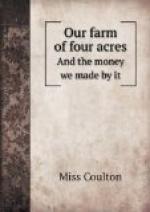From that time we have been well recompensed for our peas, tares, and maize, as each couple produces on an average a pair every six weeks; thus the produce was worth $3 00, while the cost was something less than $1 50. Even had there been no profit derived, we should still have kept them, as we consider no place in the country complete without these beautiful and graceful little creatures. It was a subject of never-failing delight to the children, watching them as they wheeled round and round the house of an evening, and it was always considered a great privilege to be allowed to feed them.
At first the food was kept in the stable, and Tom was the feeder; but we were soon obliged to alter this, as we never went into the yard without treading on the corn. It was afterwards removed to the back kitchen, round the door of which they used to assemble in a flock, till one of the servants threw them out their allowance. They were considered “pets,” by all the household, and were so tame that they would allow themselves to be taken in the hand and stroked.
As for the young ones, who were doomed to the steak, we never saw them till they made their appearance in the pie. They were taken from the nest as soon as they were fledged.
I mention this, because we were sometimes accused by our visitors (for whose especial benefit the young ones were sometimes slain) of cruelty, in eating the “pretty creatures;” but we never found that they had any scruples in partaking of them at dinner. It was usually as they were watching of a summer evening the flight of the parent birds that we were taxed with our barbarity.
We were one day much amused by a clergyman of our acquaintance, who kept a great number of these birds in a room, and who, in default of children to pet, made pets of his pigeons. At dinner, a pigeon-pie made part of the repast. This was placed opposite a visitor, who was requested to carve the dainty. He did so, and sent a portion of it to his host. The reverend gentleman looked at the plateful sent him attentively, and then said with a sigh, “I will trouble you to exchange this for part of the other bird. This was a peculiar favorite, and I always fed it myself. I put a mark on the breast after it was picked, for I could not bear to eat the little darling!”
We always thought that this sentimental divine had better either not have had the “little darling” put into the pie, or have swallowed his feelings and his favorite at the same time.
This dish seems to occasion wit as well as sentiment, for we were once asked by a facetious friend, “Why is a pigeon in a pie like Shakspeare’s Richard III?” We “gave it up,” and were told, “Because it was bound unto the steak (stake), and could not fly.” This may perhaps be a worn-out jest, but it was fresh to the writer, and so perhaps it may be to some of her readers.
We will say a few words on the management of pigeons before we conclude this chapter.




